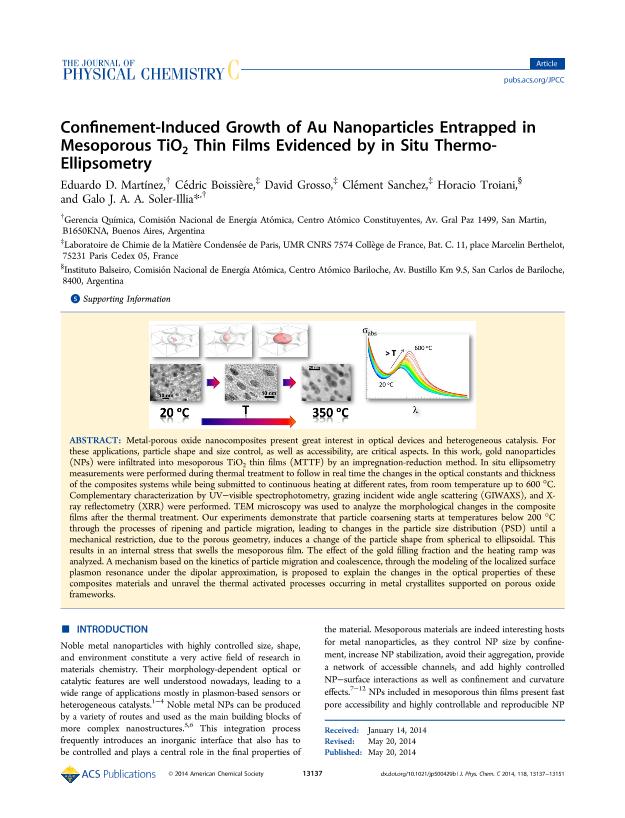Mostrar el registro sencillo del ítem
dc.contributor.author
Martínez, Eduardo David

dc.contributor.author
Cédric, Boissiere
dc.contributor.author
Grosso, David
dc.contributor.author
Sanchez, Clément
dc.contributor.author
Troiani, Horacio Esteban

dc.contributor.author
Galo, J. A. A. Soler Illia
dc.date.available
2018-01-22T14:29:25Z
dc.date.issued
2014-05-20
dc.identifier.citation
Martínez, Eduardo David; Cédric, Boissiere; Grosso, David; Sanchez, Clément; Troiani, Horacio Esteban; et al.; Confinement-Induced Growth of Au Nanoparticles Entrapped in Mesoporous TiO2 Thin Films Evidenced by in Situ Thermo- Ellipsometry; American Chemical Society; Journal of Physical Chemistry C; 24; 118; 20-5-2014; 13137-13151
dc.identifier.issn
1932-7447
dc.identifier.uri
http://hdl.handle.net/11336/34062
dc.description.abstract
Metal-porous oxide nanocomposites present great interest in optical devices and heterogeneous catalysis. For these applications, particle shape and size control, as well as accessibility, are critical aspects. In this work, gold nanoparticles (NPs) were infiltrated into mesoporous TiO2 thin films (MTTF) by an impregnation-reduction method. In situ ellipsometry measurements were performed during thermal treatment to follow in real time the changes in the optical constants and thickness of the composites systems while being submitted to continuous heating at different rates, from room temperature up to 600 °C. Complementary characterization by UV–visible spectrophotometry, grazing incident wide angle scattering (GIWAXS), and X-ray reflectometry (XRR) were performed. TEM microscopy was used to analyze the morphological changes in the composite films after the thermal treatment. Our experiments demonstrate that particle coarsening starts at temperatures below 200 °C through the processes of ripening and particle migration, leading to changes in the particle size distribution (PSD) until a mechanical restriction, due to the porous geometry, induces a change of the particle shape from spherical to ellipsoidal. This results in an internal stress that swells the mesoporous film. The effect of the gold filling fraction and the heating ramp was analyzed. A mechanism based on the kinetics of particle migration and coalescence, through the modeling of the localized surface plasmon resonance under the dipolar approximation, is proposed to explain the changes in the optical properties of these composites materials and unravel the thermal activated processes occurring in metal crystallites supported on porous oxide frameworks.
dc.format
application/pdf
dc.language.iso
eng
dc.publisher
American Chemical Society

dc.rights
info:eu-repo/semantics/openAccess
dc.rights.uri
https://creativecommons.org/licenses/by-nc-sa/2.5/ar/
dc.subject
Mesoporous Materiasl
dc.subject
Metal Nanoparticles
dc.subject
Coarsening
dc.subject
Ellipsometry
dc.subject.classification
Nano-materiales

dc.subject.classification
Nanotecnología

dc.subject.classification
INGENIERÍAS Y TECNOLOGÍAS

dc.title
Confinement-Induced Growth of Au Nanoparticles Entrapped in Mesoporous TiO2 Thin Films Evidenced by in Situ Thermo- Ellipsometry
dc.type
info:eu-repo/semantics/article
dc.type
info:ar-repo/semantics/artículo
dc.type
info:eu-repo/semantics/publishedVersion
dc.date.updated
2017-12-14T20:14:16Z
dc.journal.volume
24
dc.journal.number
118
dc.journal.pagination
13137-13151
dc.journal.pais
Estados Unidos

dc.journal.ciudad
Washington
dc.description.fil
Fil: Martínez, Eduardo David. Comisión Nacional de Energía Atómica. Gerencia del Área de Seguridad Nuclear y Ambiente. Gerencia de Química (CAC); Argentina
dc.description.fil
Fil: Cédric, Boissiere. College de France; Francia
dc.description.fil
Fil: Grosso, David. College de France; Francia
dc.description.fil
Fil: Sanchez, Clément. College de France; Francia
dc.description.fil
Fil: Troiani, Horacio Esteban. Comision Nacional de Energia Atomica. Gerencia D/area de Energia Nuclear; Argentina
dc.description.fil
Fil: Galo, J. A. A. Soler Illia. Comisión Nacional de Energía Atómica. Gerencia del Área de Seguridad Nuclear y Ambiente. Gerencia de Química (CAC); Argentina
dc.journal.title
Journal of Physical Chemistry C

dc.relation.alternativeid
info:eu-repo/semantics/altIdentifier/url/http://pubs.acs.org/doi/abs/10.1021/jp500429b
dc.relation.alternativeid
info:eu-repo/semantics/altIdentifier/doi/http://dx.doi.org/10.1021/jp500429b
Archivos asociados
